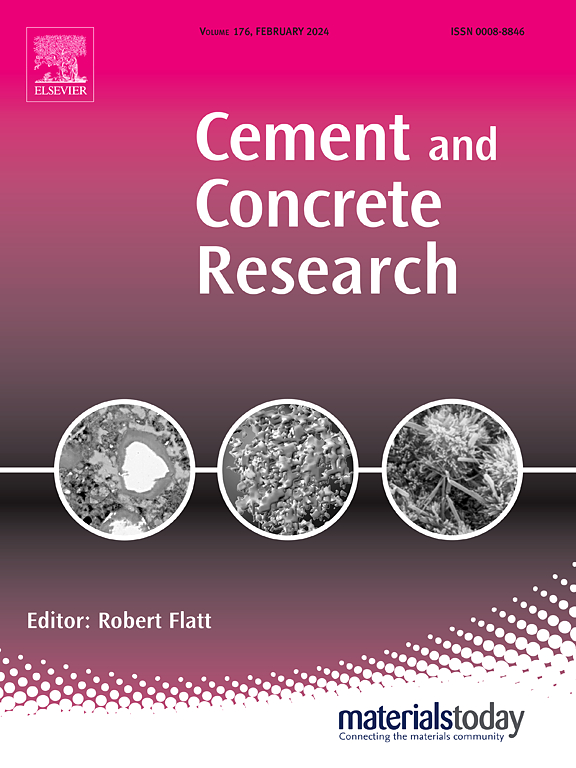BOFS中钙化合物在高重力碳化过程中物相演化和微观结构变化中的作用
IF 13.1
1区 工程技术
Q1 CONSTRUCTION & BUILDING TECHNOLOGY
引用次数: 0
摘要
高比重碳化是提高碱性氧炉渣碳化效率的一种很有前途的方法。虽然该工艺已被证明对BOFS碳化有效,但其潜在机制尚未完全了解。为此,我们选择了富氢氧化钙(CH-rich)和富硅酸钙(CS-rich)两种类型的BOFS,研究了它们在高碳化过程中碳化程度、相演化和微观结构变化的差异。我们的实验结果表明,高碳化显著减少了BOFS的碳化时间97.5%。值得注意的是,富含ch的BOFS达到了20%的碳化程度,这可归因于非原位碳化机制,暴露了未反应的核心相,从而延长了碳化时间。这一过程使富含ch的BOFS在10分钟内达到几乎完全脱钙。相比之下,富含cs的BOFS的碳化程度不到富含ch的BOFS的一半。这种限制是由于在颗粒表面迅速形成紧密堆积的方解石和脱钙的C-S-H,这限制了通过原位机制进一步碳化。为了解决这一挑战,我们提出了在高碳化之前对富含cs的BOFS进行短期预湿碳化的工艺。该综合方法通过降低初始碳化速率,成功地将富cs BOFS的碳化极限提高到13- 16%。总的来说,高碳化揭示了BOFS中钙化合物依赖的机制,为水泥工业中可扩展的二氧化碳封存和可持续的矿渣增值提供了路线图。本文章由计算机程序翻译,如有差异,请以英文原文为准。
Role of calcium compounds in BOFS on phase evolution and microstructural changes upon high-gravity carbonation
The high-gravity (higee) carbonation process has emerged as a promising method for enhancing the carbonation efficiency of basic oxygen furnace slag (BOFS). While this process has proven effective in carbonating BOFS, the underlying mechanisms are not yet fully understood. To investigate this, we selected two types of BOFS: calcium hydroxide-rich (CH-rich) and calcium silicate-rich (CS-rich) BOFS, to examine their differences in carbonation degree, phase evolution, and microstructural changes during higee carbonation. Our experimental findings reveal that higee carbonation significantly reduces the carbonation time for BOFS by 97.5 %. Notably, the CH-rich BOFS achieves a carbonation degree of 20 %, which can be attributed to ex-situ carbonation mechanisms that expose unreacted core phases, allowing for prolonged carbonation. This process enables CH-rich BOFS to reach near-complete decalcification within just 10 min. In contrast, the CS-rich BOFS exhibits less than half the carbonation degree compared to its CH-rich counterpart. This limitation arises from the rapid formation of tightly packed calcite and decalcified C-S-H on the particle surface, which restricts further carbonation via in-situ mechanisms. To address this challenge, we propose a short-term pre-wet carbonation process for CS-rich BOFS prior to higee carbonation. This integrated approach successfully increases the carbonation limit of CS-rich BOFS to 13-16 % by reducing the initial carbonation rate. Overall, higee carbonation reveals calcium compound-dependent mechanisms in BOFS, offering a roadmap for scalable CO2 sequestration and sustainable slag valorization in the cement industry.
求助全文
通过发布文献求助,成功后即可免费获取论文全文。
去求助
来源期刊

Cement and Concrete Research
工程技术-材料科学:综合
CiteScore
20.90
自引率
12.30%
发文量
318
审稿时长
53 days
期刊介绍:
Cement and Concrete Research is dedicated to publishing top-notch research on the materials science and engineering of cement, cement composites, mortars, concrete, and related materials incorporating cement or other mineral binders. The journal prioritizes reporting significant findings in research on the properties and performance of cementitious materials. It also covers novel experimental techniques, the latest analytical and modeling methods, examination and diagnosis of actual cement and concrete structures, and the exploration of potential improvements in materials.
 求助内容:
求助内容: 应助结果提醒方式:
应助结果提醒方式:


